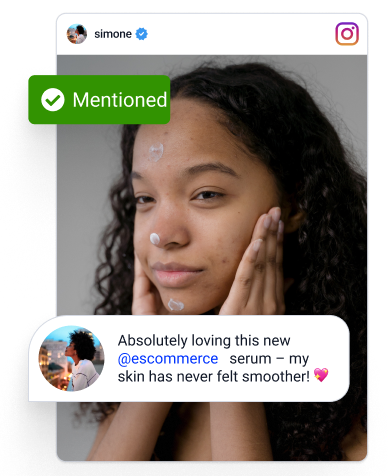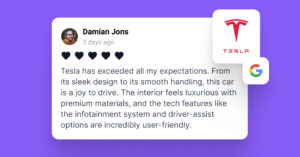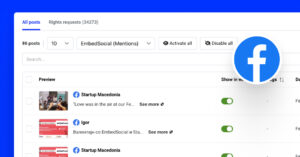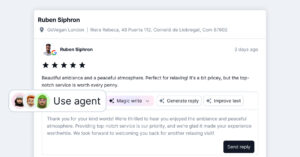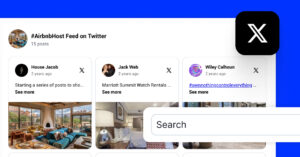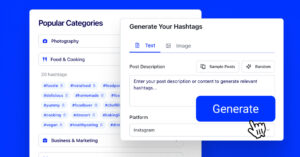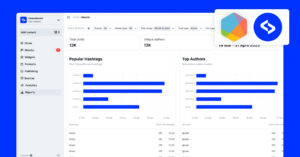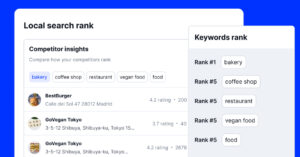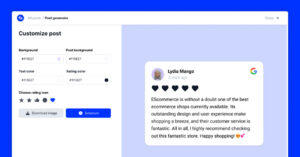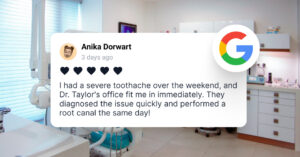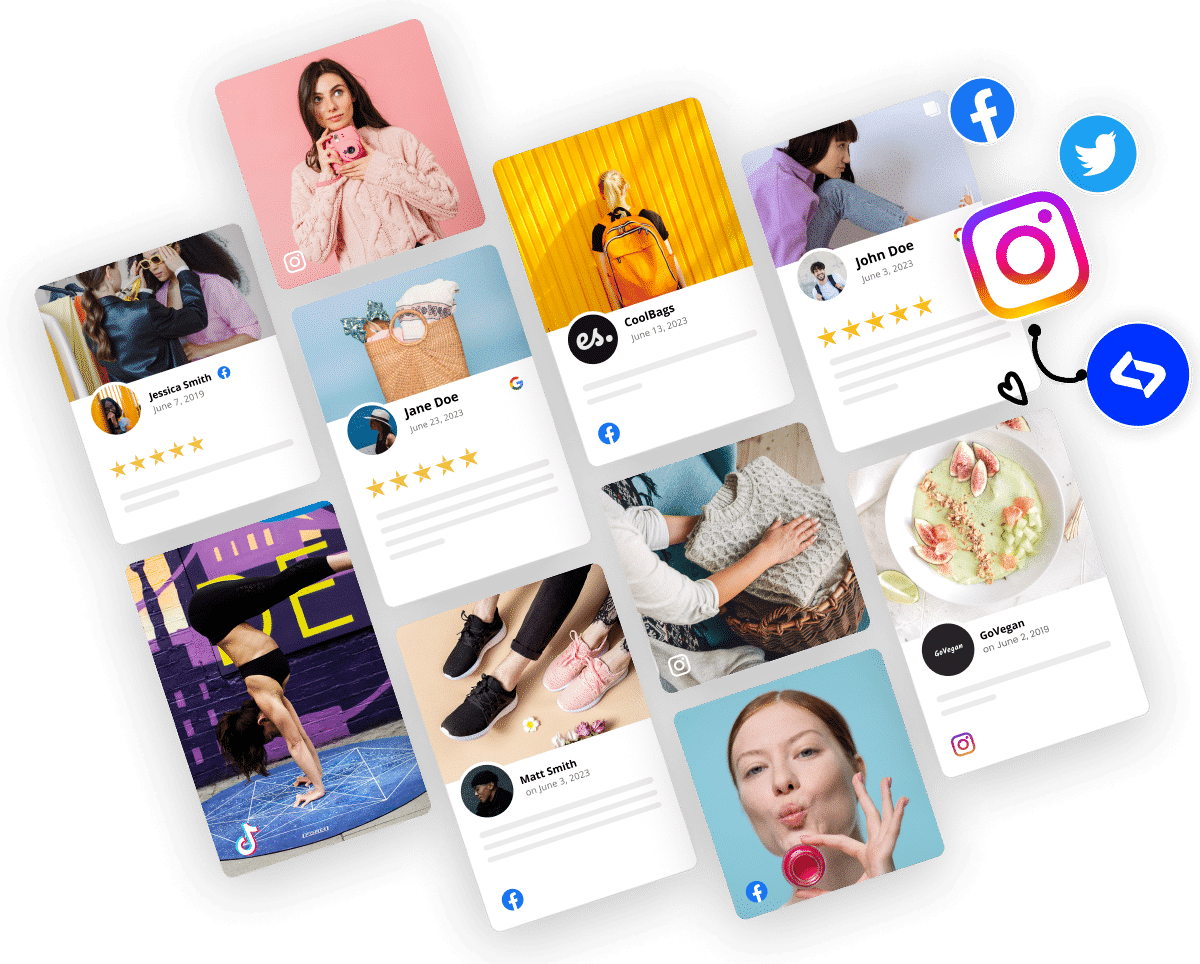Quer saber como é que os seus concorrentes se estão a sair nas redes sociais e qual a sua posição? É aí que entra a avaliação comparativa da concorrência nas redes sociais.
Ajuda-o analisar o seu desempenho, descobrir tendências e detetar lacunas na sua própria estratégia. Em suma, não se trata apenas de adivinhar, mas de comparar a concorrência com dados.
Isto é mais do que apenas espiar os outros, pois trata-se de ganhar contexto, definir objectivos mais inteligentes e utilizar a avaliação comparativa da concorrência para liderar em vez de seguir.
Então, porque não lhe mostro como fazer o benchmarking da concorrência, que ferramentas utilizar e como juntar tudo isto para aumentar o desempenho da sua marca?
O que é a avaliação comparativa da concorrência nas redes sociais?
A avaliação comparativa da concorrência nas redes sociais é a processo de análise do desempenho dos seus concorrentes nas redes sociais e comparação com o seu próprio desempenho. Ajuda-o a compreender quais as estratégias de conteúdo que funcionam no seu sector, qual a sua posição e como pode melhorar.
Definição de "avaliação comparativa da concorrência nas redes sociais
Este tipo de avaliação comparativa da concorrência envolve o acompanhamento de métricas como taxas de envolvimento, crescimento de seguidores, formatos de conteúdo e frequência de publicação para descobrir tendências e identificar lacunas no desempenho. Não se trata apenas de observar os seus concorrentes, trata-se de aprender com eles.
Redes sociais ferramentas de acompanhamento da concorrência como o EmbedSocial facilitam a análise da concorrência, permitindo-lhe monitorizar o conteúdo dos concorrentes, analisar sentimento de marcae criar referências visuais - tudo num único local.
Por que razão deve monitorizar os concorrentes nas redes sociais?
Monitorizar as redes sociais dos seus concorrentes pode trazer vantagens importantes para a sua estratégia de marketing. Afinal, está a ter um vislumbre das estratégias de redes sociais dos seus concorrentes:

- Compreender a sua posição no mercado-ver como a sua marca se compara em termos de visibilidade em linha, quota-parte de voze o empenhamento;
- Detecte tendências de conteúdo com antecedência-descobrir quais os formatos ou tópicos que estão a gerar interações no seu nicho;
- Identificar o que funciona (e o que não funciona)-aprender com os êxitos e os erros dos seus concorrentes;
- Revelar o sentimento e as preferências do público-fazer um análise de sentimentos para compreender como os clientes reagem a diferentes estilos de mensagens;
- Encontrar oportunidades para se diferenciar-detetar lacunas nas estratégias dos seus concorrentes onde a sua marca se pode destacar;
- Aperfeiçoe a sua estratégia com dados reais-Utilize as informações reais sobre o desempenho para melhorar o seu conteúdo e o seu alcance.
A ferramenta certa - como a EmbedSocial - pode tornar tudo isto mais fácil, automatizando a recolha de dados e apresentando-os em relatórios claros e acionáveis.
Como fazer uma avaliação comparativa da concorrência nas redes sociais com a EmbedSocial?
Deixe-me guiá-lo por um processo simples, mas eficaz, de avaliação comparativa da concorrência, mostrando como uma ferramenta como EmbedSocial ajuda-o a passar mais rapidamente da perceção à ação. Não existe uma forma melhor e mais rápida de detetar tendências emergentes e aumentar a satisfação dos seus clientes.
Depois de criar a sua conta EmbedSocialeis o que pode fazer:
1. Identifique os seus principais concorrentes
Incentive os seus clientes a deixarem selecionar 3 a 5 marcas com as quais concorre direta ou indiretamente. Concentre-se nas empresas que visam públicos semelhantes ou que produzem conteúdos comparáveis.
Com o EmbedSocial, pode acompanhar as menções e o UGC relacionados com perfis de marcas públicas, ajudando-o a descobrir quais os concorrentes que estão a dominar o seu espaço.
Por exemplo, eis como os gestores das redes sociais da Nike podem fazer isso. Podem ver todas as últimas publicações públicas dos seus concorrentes diretos numa janela útil:

2. Escolher plataformas sociais relevantes
Nem todas as plataformas têm a mesma importância. Escolha as que onde tanto a sua marca como os seus concorrentes estão activos-Instagram, Facebook, X, LinkedIn ou TikTok.
O EmbedSocial permite-lhe extrair conteúdos e interações de todas as plataformas populares de redes sociais, para que não tenha de verificar cada rede social individualmente:

3. Defina as suas métricas de avaliação comparativa
Decidir o que medir-crescimento de seguidores, taxa de envolvimento, utilização de hashtag, tipos de conteúdo, ou quota-parte de voz. Estes indicadores-chave de desempenho irão moldar a sua análise.
Seja qual for a sua decisão, o EmbedSocial oferece-lhe vários indicadores-chave de desempenho para análise, incluindo autores, tipos de conteúdo, análise de sentimentos e muito mais:

4. Monitorizar regularmente o conteúdo e a participação dos concorrentes
Acompanhe a frequência com que publicam, que formatos de conteúdo utilizampor quais as mensagens que suscitam mais interação. Os padrões começarão a surgir rapidamente.
Como viu acima, o ferramentas de monitorização das redes sociais ajudam-no a descobrir conteúdos de tendências, a descobrir hashtags frequentemente utilizadas e a monitorizar os consumidores em tempo real.
5. Comparar o desempenho com o da sua própria marca
Empilhe as suas métricas de desempenho lado a lado para ver como está a ser avaliado. Dessa forma, revela lacunas, estratégias vencedoraspor áreas com fraco desempenho.
O Benchmarking dentro do EmbedSocial facilita a comparação do seu envolvimento e alcance com os dos seus concorrentes - visualmente e em formatos exportáveis.
Pode simplesmente executar o serviço de análise em todos os concorrentes que escolher e depois comparar todos os gráficos relevantes para descobrir tendências e áreas a melhorar.
6. Ajustar a sua estratégia para as redes sociais com base nas informações obtidas
Por fim, transforme a sua análise em ação. Ajuste a sua frequência de publicação, comece a comparar contas de redes sociais de outras plataformas, teste novos tipos de conteúdo, adopte tácticas que considere eficazes para outros e faça tudo isto regularmente.
O EmbedSocial permite-lhe gerar e partilhar relatórios de benchmarking com a sua equipa, ajudando-o a tomar decisões mais inteligentes e rápidas com base em dados reais.
As melhores ferramentas para monitorizar as redes sociais dos concorrentes
Para acompanhar os seus concorrentes de forma eficaz, precisa de uma ferramenta fiável que vá além das estatísticas de nível superficial. De ferramentas de escuta social a plataformas de comparação de compromissos, a escolha certa tornará a sua avaliação comparativa da concorrência acionável.
Dito isto, aqui estão cinco das melhores ferramentas para monitorizar as redes sociais dos concorrentes, começando por uma criada para o desempenho e a simplicidade.
EmbedSocial - O melhor para a avaliação comparativa visual e as informações orientadas para o UGC
O EmbedSocial é um programa tudo-em-um UGC (Conteúdo Gerado pelo Usuário) que também inclui monitorização de redes sociais, ferramentas concebidas para ajudar as marcas e as agências a monitorizar, analisar e avaliar a presença dos seus concorrentes nas redes sociais. Com monitorização social da EmbedSocialCom a ajuda de um sistema de gestão de informação, rastreio de palavras-chave e relatórios visuais, ajuda as equipas a manterem-se a par do que os outros no sector estão a fazer e do seu desempenho:

Eis o que faz da EmbedSocial a melhor escolha para a avaliação comparativa da concorrência nas redes sociais:
- Acompanhar o conteúdo dos concorrentes em todas as plataformas-ver publicações em tempo real de contas públicas no Facebook, Instagram e muito mais;
- Monitorizar as menções e hashtags da marca-um excelente ferramenta de monitorização da marca para definir accionadores de palavras-chave para acompanhar as campanhas e o sentimento dos utilizadores;
- Analisar o envolvimento e o sentimento lado a lado-comparar as reacções às suas publicações e às deles num único painel de controlo;
- Gerar relatórios de avaliação comparativa da concorrência-exportar rapidamente comparações visuais entre várias métricas, que fornecem informações valiosas;
- Detetar tendências e oportunidades de conteúdo-descobrir quais os formatos ou tópicos que estão a ter impacto no público dos seus concorrentes;
- Partilhar informações entre equipas-Transforme estes relatórios da indústria e dados da concorrência em ação, exportando e partilhando relatórios de marca.
Se a sua marca precisa de uma forma simplificada de comparar a concorrência utilizando informações visuais, acompanhar menções e combinar a análise de UGC com a escuta social, o EmbedSocial é a melhor opção - especialmente para agências e empresas multi-localizadas.
Sprout Social - Melhor para relatórios competitivos a nível empresarial
O Sprout Social oferece ferramentas robustas para analisar os concorrentes em escala. Foi concebido para empresas que necessitam de relatórios detalhados e funcionalidades de colaboração entre vários membros da equipa ou departamentos. Se quiser aprofundar métricas como a quota de voz e a eficácia do conteúdo, esta é uma escolha sólida:

Aqui estão os principais recursos do Sprout Social para monitorar os concorrentes nas redes sociais:
- Comparar o crescimento de seguidores entre marcas-Acompanhar os ganhos e perdas para aferir o desempenho ao longo do tempo;
- Medir a quota-parte de voz-ver a atenção que os seus concorrentes estão a receber nas conversas do sector;
- Analisar o envolvimento pós-nível-Analisar o desempenho de cada publicação da concorrência em termos de gostos, comentários e partilhas;
- Acompanhar as tendências através de painéis de controlomonitorizar palavras-chave e hashtags utilizadas por marcas concorrentes;
- Colaborar com as ferramentas de elaboração de relatórios da equipa-partilhar facilmente as informações sobre a concorrência com as equipas internas;
- Automatizar relatórios da concorrência-receba regularmente resumos por correio eletrónico sobre a sua posição e a dos seus concorrentes.
O Sprout Social é ideal para equipas maiores e marcas empresariais que necessitam de análises aprofundadas, relatórios estruturados e a capacidade de monitorizar vários concorrentes em vários canais à escala.
Hootsuite - Ideal para gerir e monitorizar num único painel de controlo
O Hootsuite combina o agendamento com a monitorização, o que o torna uma escolha inteligente para os profissionais de marketing que pretendem gerir conteúdos e, ao mesmo tempo, controlar a concorrência. Pode criar fluxos para hashtags, perfis de concorrentes ou palavras-chave - tudo a partir de um único painel de controlo:

Estas funcionalidades da Hootsuite são úteis para a avaliação comparativa da concorrência nas redes sociais:
- Configurar fluxos de monitorização em tempo real-rastrear facilmente perfis de concorrentes, hashtags ou palavras-chave;
- Comparar tendências de envolvimento entre contas-analisar quais as marcas que estão a ter mais tração;
- Acompanhar a atividade dos concorrentes por plataforma-ver o que estão a publicar e onde;
- Detetar conteúdos da concorrência com elevado desempenho-encontrar as principais mensagens com base no envolvimento;
- Medir o sentimento através de integrações de terceiros-extenda o poder do Hootsuite com complementos de escuta;
- Centralizar as informações num único painel de controlo-não é necessário saltar entre plataformas.
O Hootsuite é uma óptima solução para equipas mais pequenas ou profissionais de marketing individuais que pretendem uma forma fácil de monitorizar a concorrência e, ao mesmo tempo, gerir o seu próprio calendário de publicações.
Mention - Melhor para alertas e escuta social em tempo real
A Mention é especializada na monitorização em tempo real, fornecendo-lhe actualizações instantâneas sempre que os seus concorrentes são mencionados online. É leve mas potente, perfeito para os profissionais de marketing que pretendem captar as conversas sociais à medida que estas acontecem e avaliar o sentimento em todos os canais:

As principais caraterísticas que suportam a avaliação comparativa da concorrência incluem:
- Definir alertas personalizados para nomes de concorrentes-ser notificado quando são mencionados nas redes sociais ou na Web;
- Monitorizar palavras-chave e hashtags de marca-ver quais os termos que estão associados às campanhas dos seus concorrentes;
- Analisar o sentimento em tempo real-detetar se as menções são positivas, neutras ou negativas;
- Exportar dados da concorrência para relatórios-transformar os dados de escuta em relatórios que podem ser apresentados;
- Comparar o volume de menções ao longo do tempo-ver como é que o seu burburinho se compara com o deles;
- Comparar as actividades sociais e de RP em conjunto-Acompanhe também as notícias, os blogues e os fóruns.
Se o seu principal objetivo é manter-se a par das menções, hashtags ou sentimentos da marca à medida que vão surgindo, o Mention é perfeito para equipas magras ou profissionais a solo que pretendem alertas rápidos e informações acionáveis.
Meltwater - Melhor para avaliação comparativa global e informação sobre os meios de comunicação social
A Meltwater é uma plataforma de topo que oferece análises avançadas das redes sociais, dos meios de comunicação social e dos conteúdos digitais. É a mais adequada para as marcas que pretendem ter uma visão mais ampla da atividade dos concorrentes, que inclui tanto os meios de comunicação social como o desempenho social:

Estas caraterísticas tornam o Meltwater ideal para a avaliação comparativa dos concorrentes a nível global:
- Monitorizar as menções da concorrência nas redes sociais e nos meios de comunicação social-pista onde são apresentados e discutidos;
- Analisar o sentimento da marca em todos os canais-ver como evolui a perceção do público por região ou tema;
- Identificar os principais influenciadores das marcas concorrentes-ver quem está a aumentar o seu alcance;
- Utilizar a IA para detetar tendências de conteúdos-obter informações automatizadas sobre o que está a impulsionar o envolvimento;
- Comparar a quota de voz da marca-medir a visibilidade dos seus concorrentes na conversa;
- Exportar relatórios globais de avaliação comparativa-ideal para as partes interessadas da empresa e para as equipas regionais.
Meltwater é ideal para empresas ou equipas centradas nas relações públicas que precisam de seguir os concorrentes nas redes sociais e nos meios de comunicação tradicionais em todo o mundo.
Exemplos reais de avaliação comparativa da concorrência nas redes sociais
Ver como outras marcas avaliam os seus concorrentes no mundo real torna o processo mais prático e inspirador. Seguem-se três exemplos de como as empresas podem utilizar a avaliação comparativa da concorrência para se manterem à frente nas redes sociais:
1. Uma marca de cuidados de pele DTC que segue as estratégias dos influenciadores
Imagine uma startup de cuidados da pele em rápido crescimento que segue as campanhas do Instagram de 5 marcas de beleza concorrentes para analisar os tipos de influenciadores, a frequência das publicações e o envolvimento.
Ao avaliar o número de publicações patrocinadas e monitorizar a utilização de hashtags, podem afinar as suas próprias publicações. Melhores práticas de UGC para duplicar o seu alcance.
Com ferramentas como a EmbedSocial, podem definir palavras-chave e análise de hashtag para automatizar este processo e gerar relatórios visuais para cada concorrente.
2. Uma cadeia de restaurantes que analisa as avaliações e o sentimento do Google
Agora, imagine um franchising de restaurantes com vários locais que quer perceber porque é que uma cadeia rival está a ganhar popularidade no Google.
Através da avaliação comparativa do volume de revisões, Classificações por estrelas do Googlee palavras-chave de sentimento, podem descobrir que tempos de resposta mais rápidos e carregamentos de imagens consistentes são os principais factores. Dessa forma, podem atualizar o seu plano de ação em conformidade.
Utilizando o EmbedSocial, podem obter todos os Avaliações do Google para ambas as marcas, visualizar tendências de sentimento e gerar automaticamente relatórios de avaliação em linha.
3. Uma empresa SaaS que avalia o desempenho do conteúdo do LinkedIn
Por fim, imagine uma marca B2B SaaS a avaliar o desempenho do LinkedIn, acompanhando o envolvimento, a frequência e o tom das publicações de quatro concorrentes diretos.
Тhere, eles percebem que os concorrentes se inclinam fortemente para posts liderados por fundadores e histórias de clientes, então sua equipe muda para incluir mais conteúdo de bastidores.
Com a comparação de feeds e as ferramentas de agendamento do EmbedSocial, esta análise poderia ter sido simplificada e os insights acompanhados ao longo do tempo.
Erros comuns a evitar ao avaliar a concorrência
Mesmo com as ferramentas corretas, o benchmarking pode sair do caminho se não tiver em conta estas armadilhas.

- Concentrar-se apenas em métricas de vaidade-Não se limite a registar contagens de seguidores ou gostos sem contexto;
- Ignorar os conhecimentos qualitativos-O benchmarking não é apenas números; o tom, o design e a mensagem também são importantes;
- Acompanhamento de demasiados concorrentes em simultâneo-mantenha a sua lista concentrada para que as informações permaneçam relevantes e fáceis de gerir;
- Não segmentar por plataforma-O que funciona no LinkedIn pode falhar no TikTok, por isso, trate cada canal individualmente;
- Não atuar de acordo com os conhecimentos adquiridos-A recolha de dados só é útil se os utilizar efetivamente para orientar a sua estratégia;
- Utilização de métodos de rastreio manuais-As folhas de cálculo podem ficar desorganizadas e desactualizadas rapidamente sem ferramentas de automatização como a EmbedSocial.
Evitar estes erros ajudá-lo-á a fazer uma avaliação comparativa com um objetivo, poupar-lhe-á muito tempo, esforço e dinheiro e, na verdade, melhorará o seu desempenho no processo.
Conclusão: A avaliação comparativa da concorrência é a chave para decisões mais inteligentes em matéria de redes sociais!
Acompanhar os seus concorrentes é aprender o que funciona, evitar o que não funciona e utilizar dados reais para criar uma estratégia mais inteligente - não copiá-los!
Quando bem feito, o benchmarking da concorrência nas redes sociais dá-lhe uma vantagem competitiva, permite-lhe adaptar-se mais rapidamente e crescer mais forte. Para isso, precisa de ferramentas como a EmbedSocial.
Assim, a análise da concorrência torna-se mais fácil, mais perspicaz e até agradável. Além disso, pode monitorizar, comparar e agir com base nas informações sobre a concorrência que recolheu!
Pronto para começar a fazer benchmarking de forma mais inteligente? Experimente o EmbedSocial hoje mesmo.
Perguntas frequentes sobre a avaliação comparativa da concorrência nas redes sociais
O que é a avaliação comparativa da concorrência?
O benchmarking da concorrência, ou benchmarking competitivo, é o processo de comparação do desempenho da sua marca com o dos principais concorrentes. Ajuda a identificar os pontos fortes, os pontos fracos e as oportunidades de crescimento, acompanhando métricas como o envolvimento, o crescimento do número de seguidores e o sentimento.
Como criar uma referência competitiva?
Está a pensar "Como fazer uma avaliação comparativa da concorrência"? Em primeiro lugar, selecione os seus principais concorrentes e defina KPIs relevantes, como a frequência de publicação, a taxa de envolvimento e o tipo de conteúdo. Em seguida, utilize ferramentas de avaliação comparativa da concorrência nas redes sociais para recolher dados e compará-los com os seus.
Qual é a melhor forma de monitorizar os concorrentes nas redes sociais?
A melhor forma de monitorizar as redes sociais dos concorrentes é utilizar ferramentas específicas como EmbedSocial que acompanham as menções, hashtags, envolvimento e tendências de conteúdo em todas as plataformas. Isto permite-lhe manter-se à frente e adaptar a sua estratégia com base em informações em tempo real.
Quais são as métricas mais importantes para a avaliação comparativa?
As principais métricas incluem a taxa de envolvimento, o crescimento do número de seguidores, a frequência das publicações, o sentimento, a partilha de voz e o desempenho dos conteúdos. Estes indicadores oferecem uma imagem completa quando monitoriza os seus concorrentes e faz uma avaliação comparativa interna dos seus esforços nas redes sociais.
Com que frequência devo efetuar uma análise de benchmarking da concorrência?
Deve efetuar uma avaliação comparativa da concorrência nas redes sociais trimestral ou mensalmente para detetar tendências atempadamente e responder às movimentações dos seus concorrentes do sector e às mudanças do mercado. Poderá ser necessário efetuar um acompanhamento mais frequente durante as campanhas ou os impulsos sazonais para uma maior agilidade.
Que ferramenta posso utilizar para monitorizar o conteúdo e o envolvimento dos concorrentes?
Ferramentas como EmbedSocial oferecer uma poderosa monitorização social da EmbedSocialO sistema de gestão de redes sociais da Microsoft inclui funcionalidades de monitorização da concorrência e relatórios. Pode monitorizar o desempenho da marca dos concorrentes nas redes sociais num único local, comparar o envolvimento e gerar relatórios de referência em segundos.
